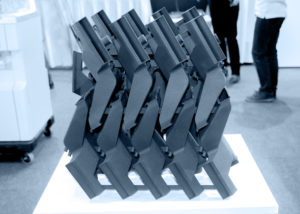Intro
3D printing has made a lot of progress in the past few decades. It used to be a hobbyist’s technology to make fun parts, but it’s quickly becoming a critical part of industries across the globe. One reason why 3D printing is so impressive today is because of how MJF printers work, and Polyamide as a material.
In this quick guide, we’ll explain how MJF printers actually work, and why Polyamide is such an impressive option.
What Is Multi Jet Fusion (MJF)?
To put it simply, an MJF printer fuses together powder to make a solid piece. Like other 3D printers, it will create one layer at a time. After a layer is built on the XY-plane, the build plate moves down a little bit, a new layer of powder is spread, and the next layer is printed.
Doing so bonds all of the layers to one another. As the build plate descends, the part gets taller and more complete.
If you’re familiar with 3D printing, you might notice that this sounds a lot like Selective Laser Sintering (SLS). The key difference is that MJF printers use infrared energy instead of a physical laser. The result is better bonding and adhesion across the part. It also allows for tougher materials to be printed on an MJF printer.
The powder used will be what material the final part is made out of. With a standard MJF, print shops will typically use a hard plastic or nylon. A very common option is Polyamide.
All About Polyamide, the Material
In a lot of designed applications, material selection is one of the most important considerations. The wrong material could ruin your prototype, production unit, or test part.
This is why a lot of people opt for high-quality Polyamide in their prints.
As a material, Polyamide is strong, abrasion-resistant, durable, and long-lasting. It can be easily finished, which allows you to change the aesthetics
of the final part.
The material is relatively inexpensive, meaning you can save money with each part without sacrificing on quality or looks.
The Process of Getting 3D-Printed Polyamide Parts

If you’re not familiar with the process of having someone make you a 3D-printed part, we’ll walk you through it.
It starts with a 3D CAD model. This is where you’ll fully design your part and add all the features you’re looking for.
From there, the model can be fed directly into an MJF machine as G-code (a language that basically tells the machine what to do and when to do it). A printing expert will load Polyamide into the MJF machine, set it up, and start running the program.
From there, it’s a hands-off operation. The MJF printer will do all the work. After the print is done fusing together, layer-by-layer, it will cool for a day or two.
Once cool, the printing expert will sort through the pile of Polyamide dust to find the part, remove it from the pile, and start cleaning it. The part will typically go through an air blasting and vacuuming process to remove all excess dust.
Most of the remaining dust can be recycled and reused without spending money, time, or energy to make it usable — this is an added bonus of using additive manufacturing.
After all of that is done, the print shop will do a final inspection against the 3D model that you send over. If everything matches, then they’ll do finishing steps like polishing, painting, or sanding. From there, they’ll send it to your facility for use.
When you receive the part, it will be a fully functioning unit.
MJF Vs. Other 3D Printing
There are a few other 3D printing options that can make parts that look and act similarly. The big difference is the material option, strength of the part, aesthetics, and performance.
Since MJF printers use infrared energy to fuse together the powder, you won’t have any weakness or seams across the part. With traditional FDM printing, a part will likely break between layers, since the bonding between layers isn’t very strong.
The other difference is the ability to use Polyamide. Other 3D printer technologies can use nylon-infused material or nylon-adjacent options, but they can’t print Polyamide with the same quality and finish that an MJF printer can.
Conclusion
Now you know more about MJF printers. Printing with Polyamide is a great way to get a high-strength, durable, highly usable part for your operation.
If you want to get your own Polyamide part MJF-printed today, reach out to our printing experts at Rapid Axis. MJF printers are a part of our impressive list of services that we offer. Get a free quote today.
